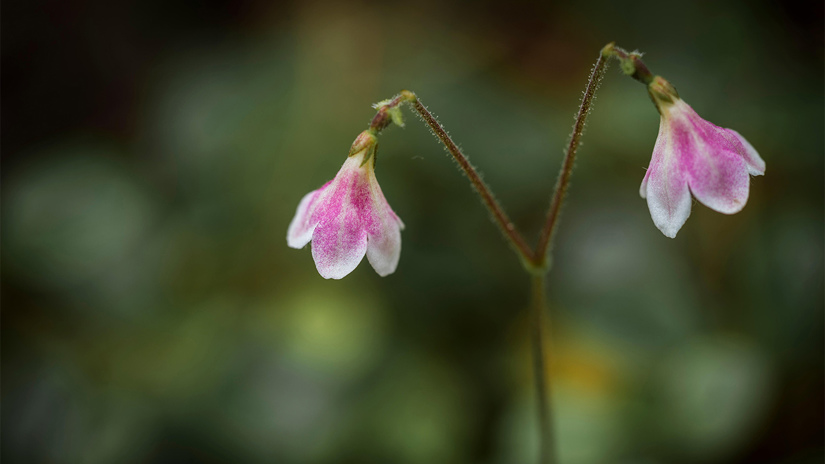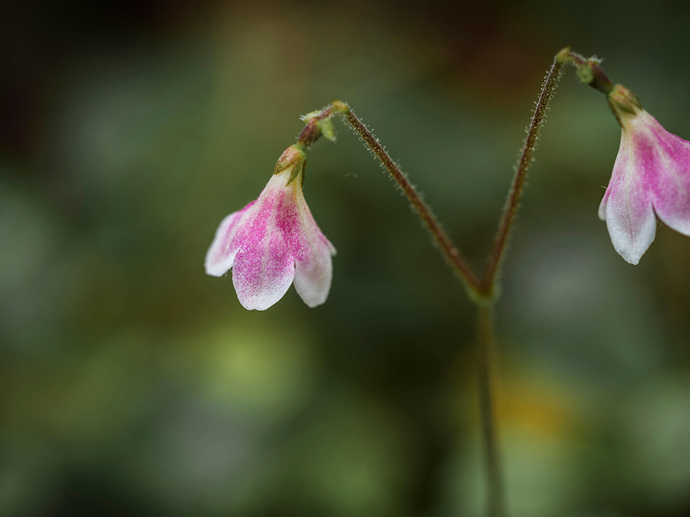

12 rare wild flowers in the UK's woods
Charlotte Varela • 13 May 2025
Woodlands are home to some of the UK's rarest wild flowers. From parasitic plants to alluring orchids, discover 12 rare woodland flowers and what makes them so uncommon.
From the dazzling bluebells that cover ancient woodland in the spring to the bright meadows bursting with buttercups in the summer, wild flowers are what make our woods so beautiful, while providing precious nectar for invertebrates.
Trees woods and wildlife
Traditional healer and tea-time favourite. This low-growing shrub has potent medicinal powers harnessed for almost a thousand years, while its blue-black berries make excellent jams, pies and liqueurs.
Trees woods and wildlife
Enchanting and iconic, bluebells are a favourite with the fairies and a sure sign spring is in full swing. The violet glow of a bluebell wood is an incredible wildflower spectacle.
Trees woods and wildlife
Hardy and determined, the bramble uses powerful roots to grow rapidly in almost any environment. Look out for juicy blackberries in the summer to make the most of this countryside favourite.
Trees woods and wildlife
A charming sanctuary for butterflies, common in UK woodland. Look to the woodland floor for a flush of purple and you might see fritillary butterflies feeding and laying their eggs.
Trees woods and wildlife
With bright, beaming yellow flowers with the scent of coconut, common gorse is a sight to behold.
Trees woods and wildlife
A true roadside stunner, cow parsley is a familiar sight in the UK. It’s a hardy plant which is popular with pollinators and grows just about anywhere.
Trees woods and wildlife
Simple yet lovely, cowslips are synonymous with spring and Easter. Find them in woods and meadows during springtime.
Trees woods and wildlife
Attractive, psychoactive, dangerous. Found in scrub and woodland, the deadly nightshade lives up to its name. Though highly poisonous, it feeds woodland animals and even has medicinal properties.
Trees woods and wildlife
A familiar, scrambling beauty that adorns hedgerows with its pale pink flowers. Dog rose clasps on to other shrubs with curved spines to grow.
Trees woods and wildlife
A poisonous coloniser of ancient woodland, dog’s mercury is quick to sweep over the wood floor, sometimes outcompeting more delicate ancient woodland species.
Trees woods and wildlife
One of the first orchids to arrive during spring, the early purple orchid is a sight to behold.
Trees woods and wildlife
Delicate, mystical, persistent. Find enchanter’s nightshade in woods and woodland edges, flowering in summer. Considered a weed in most gardens, this plant is just one part of the complex woodland habitat.
Trees woods and wildlife
Beautiful but deadly. This familiar flower has the power to cure and kill.
Trees woods and wildlife
Tall and glowing, the greater butterfly-orchid sways over unimproved grasslands and open woods. Though not so sweet-smelling as its lesser relative, keep a nose out for it in the early evening when it is at its most pungent.
Trees woods and wildlife
Pretty, star-like and abundant along hedgerows. These plants have an explosive seed-dispersal mechanism. Disturb a large patch of them in summer and they go off like fireworks.
Trees woods and wildlife
Pretty, pink and healing, herb-robert flourishes in woodland from spring to late summer. Spot its bright flowers in shady spots in woods and grasslands.
Trees woods and wildlife
Twining, scented woodland stunner. This trumpet-like flower is a paradise for wildlife, with its sweet, heady fragrance calling to nearby species, particularly on warm summer evenings.
Trees woods and wildlife
A twining hedgerow climber with a boozy use, hop has been used in the beer-making industry for centuries. Look out for it across the UK.
Trees woods and wildlife
Clingy, luscious, misunderstood. Ivy has long been accused of strangling trees, but it doesn’t harm the tree at all, and even supports at least 50 species of wildlife.
Trees woods and wildlife
Charming and cheerful, the star-shaped flowers of the lesser celandine brighten up the woodland floor. Look out for their friendly yellow flowers on path edges in early spring.
Trees woods and wildlife
Charming, sweetly scented and highly poisonous, lily-of-the-valley is a romantic woodland stunner.
Trees woods and wildlife
Sweet by name, sweet by nature. Meadowsweet might not be to everyone’s taste, but you’re unlikely to mistake the sickly sweet and frothy flower in damp woodland and bubbling out of damp ditches.
Trees woods and wildlife
Romantic, parasitic and poisonous, mistletoe loves broadleaf trees and provides an important habitat for woodland wildlife. Its leathery green leaves offer welcome colour among bare winter branches when much else is dormant.
Trees woods and wildlife
Cheerful, prophetic and mystical, there’s more than meets the eye to the humble oxeye daisy. Look out for them on roadsides and woodland edges.
Trees woods and wildlife
A rare, charming flower. If you’re in East Anglia, look for them blooming in woodland in the spring.
Trees woods and wildlife
Primroses are a cheerful sign of spring. They are one of the first woodland blooms and an important nectar source for butterflies. Look out for their friendly yellow in woodland clearings.
Trees woods and wildlife
These flashy woodland guardians have strong links to myths and mysticism. They are favourites of plenty of woodland insects – and fairies – and bloom a cheerful pink soon after the bluebell has finished flowering.
Trees woods and wildlife
One of the first signs of spring. While not native to these shores, these hardy flowers have become a familiar indicator of the shifting seasons and a sure sign that warmer weather is on its way.
Trees woods and wildlife
Romantic and showy, sweet violet grows on woodland edges, its flowers providing nectar for butterflies in early spring.
Trees woods and wildlife
Also known as old man’s beard, this woody member of the buttercup family is often seen scrambling over hedgerows.
Trees woods and wildlife
A delicious sign of the old, wild garlic is also known as ramsons. Look for them in shady woods where they coat the woodland floor in spring.
Trees woods and wildlife
Sweet in both flower and in taste, wild strawberries flourish on woodland edges and in hedgerows. Spot them in bloom in spring and in fruit in summer.
Trees woods and wildlife
Sun-loving, gentle, a mark of the old. Wood anemone is one of the first spring blooms, arriving to take in the light through the leafless canopy in broadleaf woodland. Look for them in old and ancient woodland that suits their slow growth.
Trees woods and wildlife
These dainty sleeping beauties fold up their leaves and flowers at nightfall. Seek them out in cool, damp corners of ancient woodlands where they thrive in undisturbed soils.


Charlotte Varela • 13 May 2025
Woodlands are home to some of the UK's rarest wild flowers. From parasitic plants to alluring orchids, discover 12 rare woodland flowers and what makes them so uncommon.